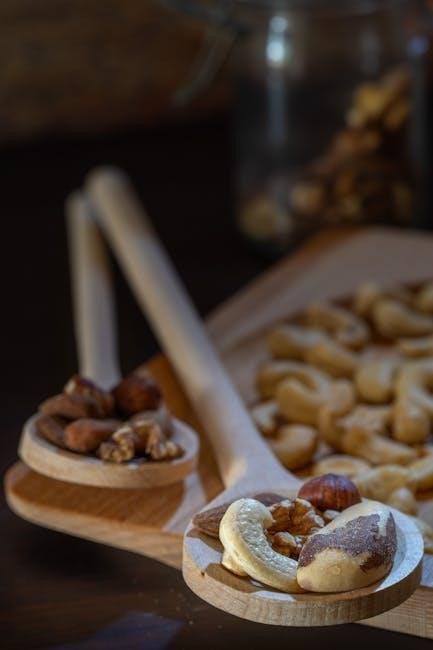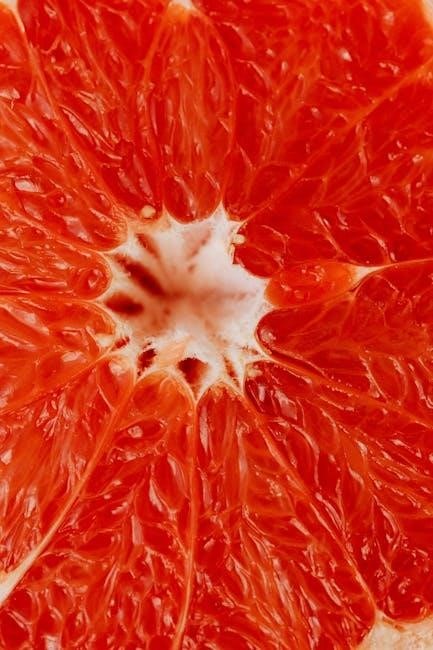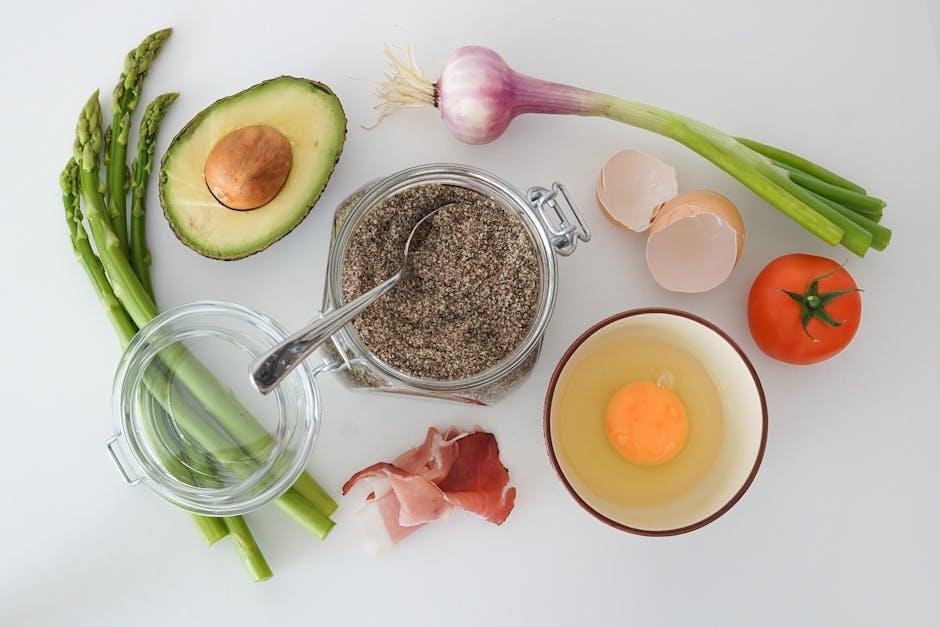The low salicylate diet is a dietary approach designed to reduce or eliminate symptoms associated with salicylate sensitivity. It focuses on minimizing foods and products containing salicylates, naturally occurring compounds found in various foods, medications, and additives. This diet is particularly beneficial for individuals with conditions like asthma, digestive issues, or skin disorders. By adhering to a low salicylate plan, many people experience improved health outcomes, including reduced inflammation and enhanced overall well-being. It’s a lifestyle adjustment that requires careful planning but can lead to significant long-term benefits with proper guidance.
What is a Low Salicylate Diet?
A low salicylate diet is a dietary plan aimed at reducing the intake of salicylates, compounds found in foods, medications, and additives. It involves eliminating high-salicylate foods and products to alleviate symptoms associated with sensitivity, such as inflammation, digestive issues, or skin conditions. The diet often starts with an elimination phase, removing high-salicylate items, followed by gradual reintroduction to identify individual tolerance levels. This approach helps manage conditions like asthma, eczema, or chronic pain. By focusing on low-salicylate alternatives, individuals can minimize adverse reactions and improve overall health. It’s a personalized strategy requiring careful planning and often guidance from healthcare professionals to ensure nutritional balance and effectiveness.
Why is the Low Salicylate Diet Important?
The low salicylate diet is important for managing symptoms linked to salicylate sensitivity, such as inflammation, digestive discomfort, and skin issues. By reducing salicylate intake, individuals can alleviate chronic conditions like asthma, eczema, and arthritis. This diet is particularly crucial for those with sensitivities, as it helps eliminate triggers that exacerbate symptoms. It provides a structured approach to identifying and avoiding problematic foods, enabling better control over health. The diet also supports long-term well-being by minimizing adverse reactions and promoting a balanced lifestyle tailored to individual needs. For many, adopting this diet is a key step toward regaining control over their health and improving quality of life.
Who Can Benefit from a Low Salicylate Diet?
Individuals with salicylate sensitivity or intolerance can greatly benefit from a low salicylate diet. This includes those experiencing chronic inflammation, digestive issues, skin conditions, or respiratory problems like asthma. Parents of children with sensitivities, such as the user’s 3-year-old with controlled asthma, also find this diet beneficial. It is particularly helpful for people with conditions like eczema, arthritis, or mast cell activation syndrome. Additionally, anyone struggling with unexplained symptoms that may be linked to salicylate intake can explore this diet. By reducing salicylate consumption, these individuals often achieve significant improvements in their health and overall well-being, making the diet a valuable tool for managing symptoms and enhancing quality of life.

Understanding Salicylates
Salicylates are natural compounds found in plants, medications, and food additives, often causing sensitivity in some individuals. They can trigger inflammation, skin issues, and respiratory problems in sensitive people.

What Are Salicylates?
Salicylates are naturally occurring compounds found in plants, serving as a defense mechanism against pathogens and pests. They are present in various foods, medications, and additives, with concentrations varying by ripeness and preparation. Salicylates are also synthetic, found in aspirin and other anti-inflammatory drugs. While beneficial for plants, they can cause sensitivity in humans, leading to symptoms like inflammation, skin rashes, and respiratory issues. Understanding salicylates is crucial for managing conditions like asthma or digestive disorders, as sensitivity can significantly impact health. Identifying and controlling salicylate intake helps individuals alleviate symptoms and improve their quality of life through tailored dietary adjustments.
Food Sources High in Salicylates
Foods high in salicylates include unripe fruits, berries, citrus fruits, and stone fruits like cherries. Vegetables such as tomatoes, bell peppers, and eggplants also contain significant amounts. Spices like cumin, paprika, and herbs like oregano and thyme are high in salicylates. Nuts, particularly almonds and pistachios, contribute to salicylate intake. Processed foods with artificial additives often contain higher levels. Understanding these sources is essential for managing salicylate sensitivity, as even small amounts can trigger symptoms in sensitive individuals. Identifying and limiting these foods helps create a balanced low-salicylate diet tailored to personal tolerance levels, promoting better health outcomes and symptom relief.
Non-Food Sources of Salicylates
Non-food sources of salicylates include medications, skincare products, and environmental factors. Aspirin and other NSAIDs contain salicylates, which can contribute to sensitivity. Cosmetics and personal care items, such as cleansers and shampoos, often include salicylic acid, a derivative of salicylates. Additionally, pollution and certain chemicals in the environment can expose individuals to salicylates; While these sources are less commonly associated with salicylate intake compared to food, they can still significantly impact sensitive individuals. Managing these non-food sources is crucial for those following a low-salicylate diet, as they can inadvertently increase salicylate exposure and trigger symptoms like inflammation or skin irritation.

Health Benefits of a Low Salicylate Diet

A low salicylate diet can reduce inflammation, improve digestive health, and alleviate skin conditions. It also supports asthma management and helps individuals with salicylate sensitivity achieve symptom relief.
Reduction in Inflammation
A low salicylate diet can significantly reduce inflammation, particularly in individuals with salicylate sensitivity. By eliminating high-salicylate foods, the body experiences less irritation, leading to decreased inflammatory responses. This is especially beneficial for those with chronic inflammatory conditions, as it helps alleviate symptoms such as joint pain and swelling. The diet also supports overall immune function by minimizing triggers that exacerbate inflammation. Many people report improved well-being and reduced discomfort after adopting this dietary approach. Managing inflammation through a low salicylate diet can lead to long-term health improvements and enhanced quality of life.
Improvement in Digestive Health
A low salicylate diet often leads to significant improvements in digestive health by reducing irritation and inflammation in the gastrointestinal tract. Many individuals report fewer symptoms of bloating, abdominal pain, and digestive discomfort after adopting this dietary approach. The elimination of high-salicylate foods can help alleviate conditions such as irritable bowel syndrome (IBS) and other digestive sensitivities. Additionally, focusing on low-salicylate foods like fresh meats, dairy, and certain grains can promote a balanced gut environment. This diet is particularly beneficial for those with food intolerances or sensitivities, offering a pathway to enhanced digestive well-being and overall health.
Alleviation of Skin Conditions
The low salicylate diet has shown promise in alleviating various skin conditions, such as eczema, acne, and rashes. By reducing the intake of salicylates, individuals often experience a decrease in skin inflammation and irritation. Many report improvements in skin clarity and a reduction in flare-ups. This dietary approach can be particularly beneficial for those with sensitivities or allergies, as it helps minimize external triggers that may exacerbate skin issues. While results vary, adopting a low salicylate diet is often a recommended step for managing chronic skin conditions alongside other treatments. It’s a holistic approach that focuses on healing from within.
Support for Asthma and Respiratory Issues
The low salicylate diet can provide significant support for individuals with asthma and respiratory issues. By reducing the intake of salicylates, which can act as irritants in sensitive individuals, the diet helps minimize triggers that may exacerbate respiratory symptoms. Many people report a noticeable improvement in breathing and a reduction in asthma attacks after adopting this dietary approach. For example, a case study shared by a parent highlighted that their child’s asthma was effectively managed through a low salicylate diet. This diet focuses on eliminating high-salicylate foods, which can contribute to inflammation and airway constriction, thereby offering a natural way to alleviate respiratory discomfort and improve overall lung health.

Food List for a Low Salicylate Diet
A low salicylate diet focuses on fresh meats, fish, dairy, and gluten-free products. Moderate salicylate foods like some vegetables are allowed, while high salicylate foods like berries and processed items are avoided. This structured approach helps maintain nutritional balance and alleviate symptoms.
Low Salicylate Foods
Fresh meats, fish, shellfish, dairy products, eggs, and gluten-free cereals are naturally low in salicylates. Rice, corn, and certain fruits like bananas and pears are also suitable. These foods provide essential nutrients while minimizing exposure to salicylates. Fresh, unprocessed items are ideal, as salicylate content increases with ripening and processing. This category ensures a balanced diet and helps manage sensitivity effectively.
Moderate Salicylate Foods
Moderate salicylate foods include certain vegetables like cucumbers, carrots, and spinach, as well as some whole grains and legumes. These foods contain higher salicylate levels than low-salicylate options but are still manageable for some individuals. Moderate intake may be acceptable depending on personal tolerance levels. It’s crucial to monitor reactions when consuming these foods, as sensitivity can vary. Incorporating them in controlled portions can help maintain nutritional balance without triggering adverse effects, making them a flexible option for those on a low salicylate diet.
High Salicylate Foods to Avoid
Foods high in salicylates, such as berries, citrus fruits, and tomatoes, should be avoided on a low salicylate diet. Processed foods with artificial additives and certain herbs like mint and oregano also fall into this category. These foods contain the highest levels of salicylates and can trigger or worsen symptoms in sensitive individuals. Eliminating them is essential to managing conditions like asthma or skin issues effectively. Understanding which foods are high in salicylates and avoiding them helps create a safer, more balanced dietary plan tailored to individual needs and health goals, ensuring optimal symptom relief and improved well-being.

Meal Planning and Recipes
Discover delicious and safe meal ideas tailored for a low salicylate diet. Plan balanced meals using approved ingredients, ensuring nutritional variety and flavor. Explore recipes and resources for easy, enjoyable cooking that supports your dietary needs while maintaining taste and satisfaction. Utilize printable guides and sample menus to streamline your meal preparation and grocery shopping experience. Create meals that are both nourishing and enjoyable, helping you stick to your low salicylate plan with ease and confidence.
Breakfast Ideas for a Low Salicylate Diet
Start your day with delicious and safe breakfast options on a low salicylate diet. Enjoy gluten-free cereals with fresh, low-salicylate fruits like bananas or pears; Scrambled eggs, omelets, or boiled eggs are excellent protein-rich choices. Consider smoothies made with almond milk, mango, or pear, ensuring all ingredients are low in salicylates. Try rice flour pancakes or toast with coconut oil or butter for a tasty morning treat. Always opt for fresh, unprocessed foods and avoid spices or additives high in salicylates. Plan ahead with overnight oats or chia pudding using approved ingredients. Remember to read labels and choose low-salicylate-friendly products to maintain your dietary goals. Breakfast can be both nourishing and enjoyable while adhering to the low salicylate guidelines.
Lunch and Dinner Recipes
Discover flavorful and safe lunch and dinner ideas tailored for a low salicylate diet. Grilled chicken or fish paired with roasted vegetables like carrots, zucchini, and green beans make a nutritious meal. Opt for fresh, peeled ingredients to minimize salicylate intake. Quinoa or rice bowls with low-salicylate vegetables such as spinach, cucumbers, and snap peas are also great options. For dinner, try stir-fries using coconut oil, fresh vegetables, and lean proteins like beef or tofu. Ensure all seasonings are low in salicylates, avoiding spices like cumin or paprika. These recipes provide balanced nutrition while adhering to dietary restrictions, helping you maintain a healthy and enjoyable low salicylate lifestyle.
Snacks and Desserts Suitable for the Diet
Enjoying snacks and desserts on a low salicylate diet is possible with careful choices. Opt for fresh, peeled fruits like bananas, pears, or mangoes, as they naturally contain lower salicylate levels. Sorbet made from allowed fruits is a refreshing dessert option. For snacks, consider vegetable sticks with dips like hummus or guacamole, ensuring ingredients are low in salicylates. Plain yogurt with approved fruits or a handful of gluten-free crackers can also satisfy cravings. Avoid processed snacks and opt for homemade treats to maintain control over ingredients. These options allow you to indulge without compromising your dietary goals, keeping your meals enjoyable and balanced.

Practical Tips for Success
Plan meals, read labels, and shop strategically. Keep a journal to track symptoms and progress. Focus on fresh, whole foods to maintain balance and avoid triggers effectively.
How to Read Food Labels
Reading food labels is crucial for managing a low salicylate diet. Look for ingredients like spices, artificial flavors, and preservatives, which often contain salicylates. Avoid products with natural flavors or additives, as these may include high-salicylate components. Check for certifications like “salicylate-free” or “hypoallergenic” to ensure safety. Be aware that even seemingly harmless items, such as certain fruits or vegetables, can have high salicylate levels when unripe or unpeeled. Always verify the ingredients list and nutrition facts to make informed choices. Consulting a registered dietitian can also help you interpret labels accurately and create a balanced, low-salicylate meal plan.
Grocery Shopping Strategies
Grocery shopping on a low salicylate diet requires careful planning and attention to detail. Start by creating a shopping list based on known low-salicylate foods, such as fresh meats, fish, dairy, eggs, and gluten-free products. Avoid processed foods, as they often contain hidden salicylates in additives or preservatives. Opt for organic or locally sourced options when possible, as they may have fewer additives. Focus on ripe, peeled fruits and vegetables, as salicylate levels decrease with ripening. Stick to your list to avoid impulse purchases and consider shopping the perimeter of the store, where whole foods are typically located. Consulting a dietitian or using a reliable food list can ensure you make safe choices.
Cooking Tips to Avoid Cross-Contamination
Cooking on a low salicylate diet requires careful attention to avoid cross-contamination with high-salicylate foods. Use separate cutting boards, knives, and utensils for low-salicylate ingredients to prevent accidental exposure. Designate specific cookware and storage containers exclusively for low-salicylate meals. Clean and sanitize all surfaces thoroughly before preparing meals. Store low-salicylate foods in sealed containers to avoid airborne salicylate transfer from nearby high-salicylate items. Label foods clearly to ensure clarity and avoid mix-ups. Consider preparing low-salicylate meals first to minimize cross-contamination risks. Disinfect utensils and tools regularly, especially if shared with others. These strategies help maintain the integrity of your diet and reduce unintended exposure to salicylates.

Common Challenges and Solutions
Common challenges include maintaining nutritional balance, dealing with cravings, and reintroducing foods safely. Strategic meal planning, using substitutes, and seeking support groups can help overcome these obstacles effectively.
Maintaining Nutritional Balance
Maintaining nutritional balance on a low salicylate diet requires careful planning to ensure adequate intake of essential nutrients. Focus on consuming a variety of low-salicylate foods, such as fresh meats, fish, dairy products, and gluten-free grains. Incorporate vegetables like lettuce, cucumbers, and carrots, which are naturally low in salicylates. Fruits should be chosen wisely, opting for ripe options like bananas and pears. Healthy fats from sources like butter, olive oil, and coconut oil are also permissible. Additionally, consider consulting a registered dietitian to tailor your diet and prevent nutrient deficiencies. Regularly reviewing and adjusting your meal plans can help sustain a balanced and nutritious lifestyle.
Dealing with Cravings
Cravings for high-salicylate foods are common but manageable on a low salicylate diet. Plan meals in advance to avoid temptation and stock up on low-salicylate alternatives. Substitute high-salicylate ingredients with permissible options, ensuring flavors remain satisfying. Allow yourself small portions of tolerated foods after an elimination period to prevent feelings of deprivation. Focus on the long-term benefits, such as improved health, to stay motivated. Joining support groups or online communities can provide encouragement and practical tips for managing cravings. Remember, consistency is key to achieving and maintaining symptom relief while adapting to this dietary lifestyle.
Reintroducing Foods After Elimination
Reintroducing foods after elimination on a low salicylate diet requires patience and careful monitoring. Start by gradually adding one food at a time, beginning with low-salicylate options, and observe your body’s reaction for several days. Keep a food diary to track any changes in symptoms, such as inflammation, digestive issues, or skin reactions. If symptoms return, stop the food immediately and wait before trying another. This process helps identify tolerance levels and ensures a balanced diet without triggering sensitivities. Over time, you may find a sustainable level of salicylate intake, allowing for a more flexible eating plan while managing symptoms effectively.

Resources and Support
Find reliable information on low salicylate diets through registered dietitians, online guides, and support groups. These resources offer meal plans, symptom management tips, and community encouragement for long-term success.
Where to Find Reliable Information
Reliable information on the low salicylate diet can be found through registered dietitians, healthcare providers, and reputable online resources. Websites like the Salicylate Sensitivity Foundation and dietitian-authored blogs provide evidence-based guides. Comprehensive PDF guides are available for download, offering detailed food lists, meal plans, and tips for managing symptoms. Support groups and forums connect individuals with shared experiences, fostering community and practical advice. Always verify sources for credibility, ensuring they align with medical or nutritional expertise. Consulting a registered dietitian is highly recommended for personalized guidance and to address specific dietary needs effectively. These resources empower individuals to navigate the diet confidently and sustainably.
Community Support Groups
Community support groups play a vital role in helping individuals navigate the low salicylate diet. Online forums, social media groups, and specialized organizations connect people with shared experiences, offering practical advice and emotional support. These platforms allow members to exchange recipes, discuss challenges, and share successes. Many groups are moderated by healthcare professionals or experienced individuals, ensuring accurate information is disseminated. Participation in these communities fosters a sense of connection and motivation, which is crucial for maintaining long-term adherence to the diet. Engaging with others who understand the unique challenges of salicylate sensitivity can make the journey more manageable and less isolating.
Consulting a Registered Dietitian
Consulting a registered dietitian is a crucial step in successfully implementing a low salicylate diet. A dietitian specializes in creating personalized meal plans tailored to individual needs, ensuring nutritional balance while avoiding high salicylate foods. They provide expert guidance on managing salicylate sensitivity, helping to identify triggers and develop strategies to reduce symptoms. Dietitians also offer practical advice on grocery shopping, meal preparation, and reintroducing foods after elimination. Their support can significantly enhance adherence to the diet and improve overall health outcomes. Seeking professional advice ensures a well-structured approach, making the transition to a low salicylate lifestyle more manageable and sustainable in the long term.
The low salicylate diet offers a tailored approach to managing symptoms like inflammation and skin issues, improving overall health. Commitment and professional guidance are key to long-term success.
Final Thoughts on the Low Salicylate Diet
The low salicylate diet is a transformative approach for those with sensitivities, offering symptom relief and improved well-being. While it requires dedication, the benefits often outweigh the challenges, making it a valuable long-term solution for many individuals.
Encouragement for Long-Term Success
Embracing the low salicylate diet can be life-changing, offering relief from symptoms and improving overall health. While it may feel restrictive at first, the long-term benefits far outweigh the challenges. Many individuals report significant improvements in digestion, skin health, and respiratory issues. Staying motivated involves celebrating small victories and focusing on how much better you feel. Meal planning and finding creative recipes can make the diet enjoyable. Remember, it’s a journey, and even small steps toward consistency can lead to positive outcomes. With patience and persistence, you can thrive on this diet and enjoy a healthier, symptom-free life.